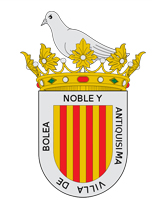|
GEOGRAPHY
The town of Bolea (584 inhabitants) is the capital of the municipality of La Sotonera (1,096 h.). It belongs to the District of la Hoya/Plana de Huesca and to the "Reino de los Mallos". It is located 20 km to the Northwest of the city of Huesca and 12 km from the castle of Loarre. Its economy is based on farming: cereals, cherries, almonds and olives; construction work; pig farms; and rural tourism. Part of the local population works in the city of Huesca nearby, in the service sector.
Heights (above sea level): Plaza Mayor (Town Hall): 656 metres, Collegiate Church: 690 metres, Muro (highest hill): 712 metres.
Geographical coordinates: 0º 33' 09'' W and 42º 15' 40'' N
HISTORY
Bolea is a place name of Iberian origin (high place), Calagurris Fibularia under Roman domination, and was the last Muslim enclave, known as Buluya, located to the north of the city of Huesca, and finally conquered after several attempts by King Pedro I of Aragon in the year 1101. Its first royal land-owners were Fortún López, Armengol de Urgell and Jimeno de Artusella. In 1174 Alfonso II gives the town to his wife Doña Sancha, as a wedding dowry. At the beginning of the 13th century, Bolea is governed by Pedro de Ahones, although in 1262 it is given as security by Jaime I to Gonzalo López and in 1295 by Jaime II to Rodrigo Jiménez de Luna, the knight commander of Montalbán. In 1402 the lady of Bolea was María de Luna, niece of Benedicto XIII and the wife of King Martín I, "el Humano" (The Humane King). In 1418 Alfonso V gave the town to his brother and future king Juan II. In 1486 Fernando II ratifies the status of Bolea as a royal town. Then in 1767, Carlos III exhorts the capitulary clergy to place special emphasis on attending to the spiritual needs of the large number of a large number of travellers staying overnight in Bolea, since it was on the main route from Huesca to Jaca, Navarre and France (Catalonian Road to Santiago de Compostela). With a wealth of agricultural products and blooming trade, it played an important role in the history of Aragon until its decline in the middle of the 18th century, due to the seizing of the church lands and property, the transfer of the trade route further south and the exodus of the population to industrial areas.
|

|